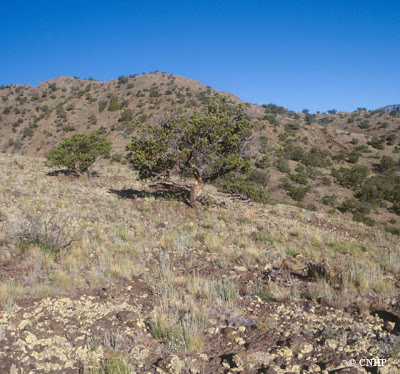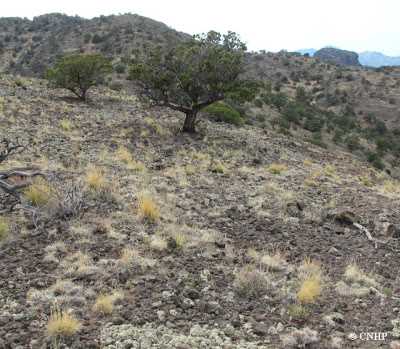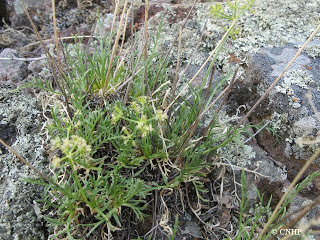On July 1, 1997, CNHP staffers Renée Rondeau and Phyllis Pineda went in search of the rock-loving Aletes (Aletes lithophila), a fragrant herbaceous perennial in the carrot family that is endemic to Colorado. Their hunt was successful, finding thousands of plants tucked into the shallow and rocky volcanic soils on ridges and north-facing slopes within the San Luis Valley. GPS devices were large and expensive in 1997, so everything was done with a compass and a paper topo map. Plants were counted, a polygon was drawn on the map, and several photos were taken (with slide film! remember film?). The resulting documentation of the location of the photos were penciled dots on the map labeled “photo.”
 |
| Aletes lithophila happily growing in 1997. |
Flash-forward 14 years. On July 4, 2011, in preparation for an upcoming field trip, Renée searched through her 1997 files and found her old slides, topo map, and field notes. She laboriously spent the 4th of July coaxing our old slide scanner into reading the slides to produce digital files that could be printed, finishing up just in time to take in Fort Collins community fireworks!
The next morning, Renée and Mindy Gottsegen (from State Land Board) headed to the Biedell Stewardship Trust parcel to look for the rock-loving Aletes. First stop was to revisit the 1997 site (on National Forest land) to get a good search image of the plant and to make sure the plant was managing to survive during the extreme drought that the San Luis Valley is currently experiencing. Estimated coordinates were entered into the hand-held GPS, and the printed photos were held aloft to compare with the modern scenery.
As Renée tells it: “As we approached our location everything started coming into focus and we started finding Aletes and seeing the striking views of volcanic cliffs and domes that were prevalent in the 1997 photo. When we saw the same dead pinyon pine from the photo, we knew we had relocated this non-descript location. The day was wearing on, so we weren’t able to fine tune our exact location before snapping a few photos, but in spite of this we did get close enough to document the change, or really lack of change, since 1997. The original photo, judging by the shadows, was taken on a clear morning and our 2011 photo was taken on a hazy afternoon, due to nearby fires. In spite of the less than precise match we can still say something about the persistence of live and dead plants.”
Reviewing the foreground, in front of the pinyon pines (both dead and alive), of the photos below, we can see that, in the relatively wet year of 1997, Aletes (the little green clumps) were common. In contrast, 2011 has been very dry in the Valley, reducing the cover and density of forbs, including Aletes. Drought tolerant grasses (all native) are a lot more noticeable in 2011 than in 1997. The live pinyon trees also haven’t changed much in fourteen years.
 |
| 1997 – view from the dead pinyon |
 |
| 2011 – still dead! |
 |
| 1997 – live pinyons |
 |
| 2011 – there they are to this day. |
The low moisture environment of the San Juan foothills is a place where plants grow slowly and decomposition is even slower. Aletes is surviving the drought but fruit production was hardly evident in 2011.
 |
| Aletes lithophila hanging on in the 21st century. |
Now that we know the precise location of the 1997 photo, perhaps Renée can go back in a wetter year and hopefully see a vibrant Aletes population once again. Renée and Mindy went on from this spot to survey the State Land Board lands and located three new populations of Aletes lithophila.
CNHP has a plethora of old slides that should be scanned in while we still have the technology. If you would like to volunteer with CNHP to help us archive our old and aging slides, please contact Renée.




